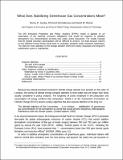| dc.contributor | Jacoby, Henry D. | en_US |
| dc.contributor | Schmalensee, Richard. | en_US |
| dc.contributor | Reiner, David M. | en_US |
| dc.date.accessioned | 2003-10-24T14:57:46Z | |
| dc.date.available | 2003-10-24T14:57:46Z | |
| dc.date.issued | 1996-11 | en_US |
| dc.identifier.other | no. 14 | en_US |
| dc.identifier.uri | http://mit.edu/globalchange/www/abstracts.html#a14 | en_US |
| dc.identifier.uri | http://hdl.handle.net/1721.1/3635 | |
| dc.description | Includes bibliographical references (p. 16). | en_US |
| dc.description | Abstract in HTML and technical report in HTML and PDF available on the Massachusetts Institute of Technology Joint Program on the Science and Policy of Global Change website (http://mit.edu/globalchange/www/). | en_US |
| dc.description.abstract | The MIT Emissions Prediction and Policy Analysis (EPPA) model is applied to an exploration of the national emissions obligations that would be required to stabilize atmospheric CO2 concentrations at levels now under active discussion. The results indicate that the needed voluntary participation will be difficult to achieve, not least because nations at very different income levels would have to undertake similarly costly emissions restrictions. The need for more attention to the linkage between short-term policy proposals and long-term stabilization goals is highlighted. | en_US |
| dc.format.extent | 16 p. | en_US |
| dc.format.extent | 103185 bytes | |
| dc.format.mimetype | application/pdf | |
| dc.language.iso | eng | en_US |
| dc.publisher | MIT Joint Program on the Science and Policy of Global Change | en_US |
| dc.relation.ispartofseries | Report no. 14 | en_US |
| dc.subject.lcc | QC981.8.C5 M58 no.14 | en_US |
| dc.title | What does stabilizing greenhouse gas concentrations mean? | en_US |
